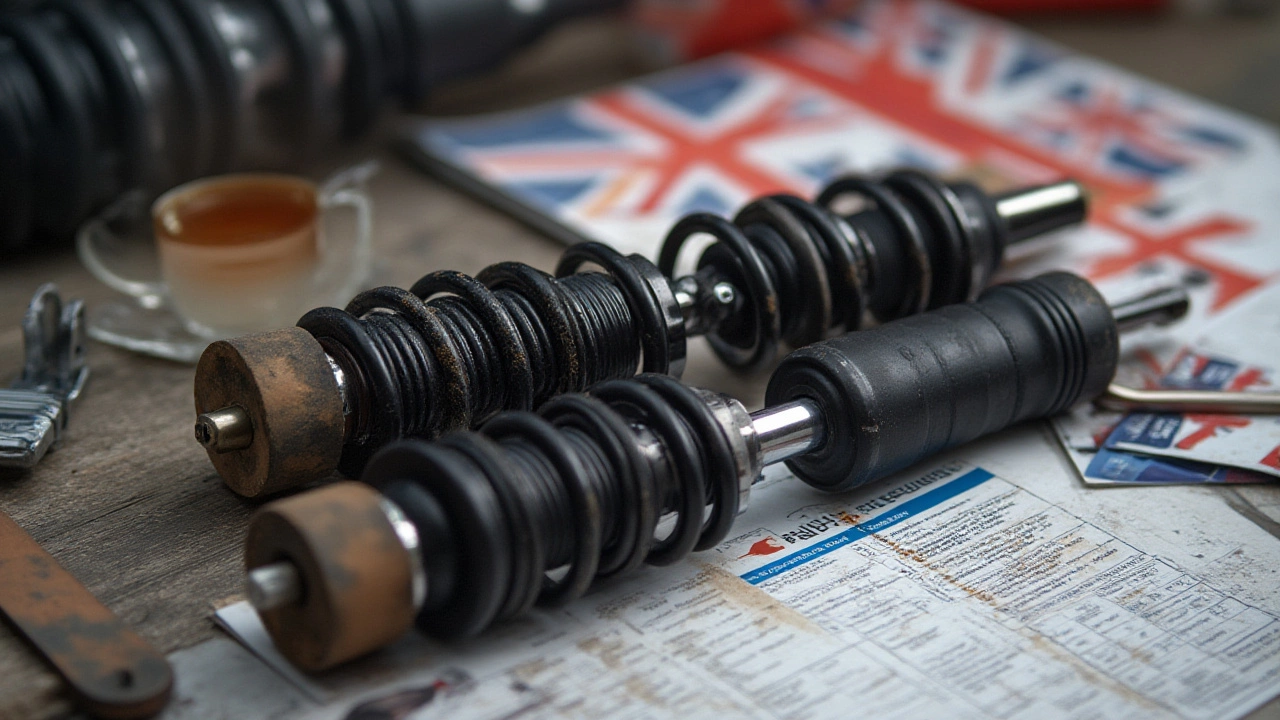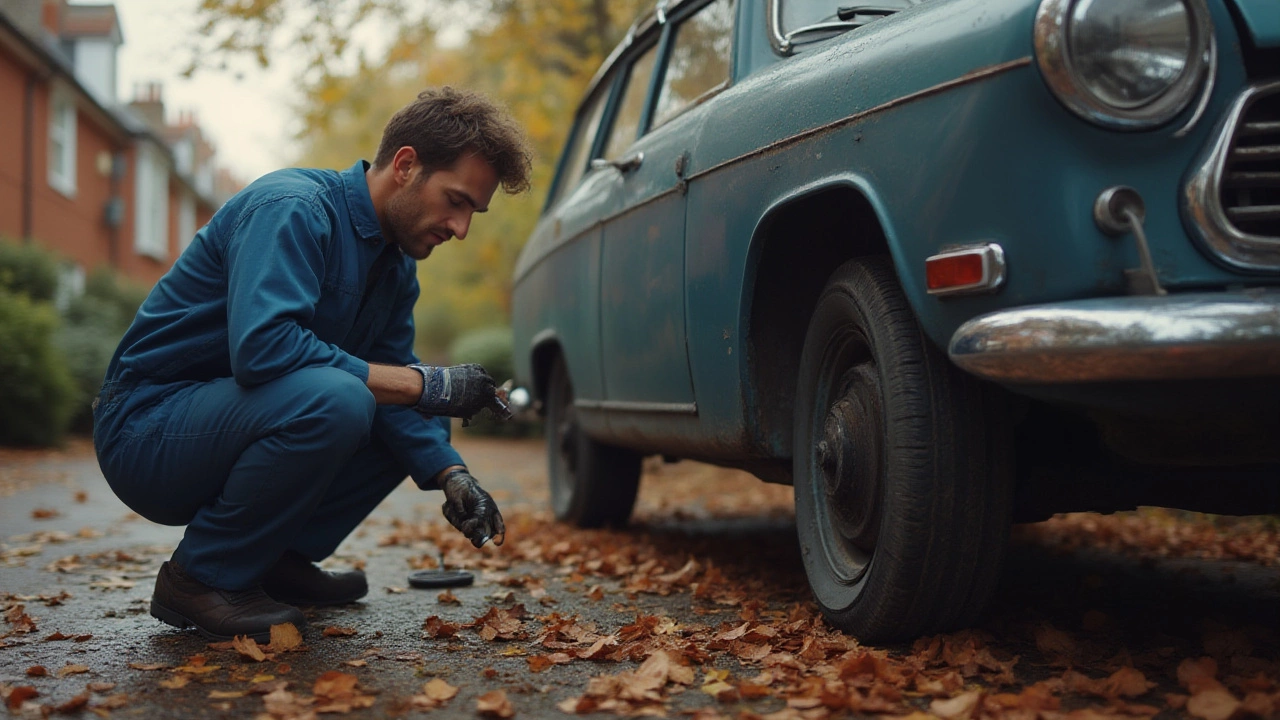That sinking feeling when you hit a bump and your car wobbles more than it should—it’s not just a bad road. Chances are, your suspension shocks have started packing it in, and ignoring them can make every journey bumpy, noisy, and worrisome. Few drivers realise how important these hidden components are until their morning commute feels like a rollercoaster ride or their tyres wear out after just a few months. Bad shocks run deeper than a bit of discomfort. If you aren’t paying attention, you could find yourself with a mess of unexpected problems: think uneven tyre wear, dangerously long stopping distances, or even damage to parts you didn’t know existed under your car. So, how do you actually spot when your shocks are done for?
Why Suspension Shocks Matter More Than You Think
Your mate might say, "It’s just a bumpy ride, nothing to worry about," but suspension shocks have one of the most thankless jobs on your vehicle. They sit at each wheel, constantly soaked in grime and rain, working to keep your tyres glued to the road. The shock absorber’s main job? Control the spring movement so your tyres stay in proper contact with the tarmac. Without shocks, you'd be bouncing down Manchester’s potholed streets like you’re on a pogo stick. And there’s a real safety aspect too. Industry tests in 2022 at Millbrook Proving Ground showed faulty shocks can make your stopping distance up to 20% longer at motorway speeds. That’s the difference between a close call and an airbag deployment.
But here’s what trips people up: shocks wear out slowly. You won’t wake up one day and find them stiff as a board or leaking oil overnight. Instead, you adjust bit by bit to the extra road noise or gentle bouncing after speed bumps. Eventually, your car just feels old, less in control. Modern shocks are gas-charged and sealed—designed to last up to 50,000 miles or more, but real-world roads, especially after an icy British winter, take their toll well before that. People who drive mostly in cities often think they’re immune, but all the stop-start action, kerb mounting, and speed humps can hammer suspension even harder than country lanes.
What about fancy active suspensions, or Magneride tech in some newer Fords and Jaguars? They still rely on physical dampers that wear, just like traditional units. The difference is, the warning signs may be subtler, and replacements can cost four times as much. In most cars though, the symptoms are classic: more body roll, slower steering response, rattles, or a ‘floaty’ sensation at motorway speeds. Missed MOT lately? It’s a common place where shocks get caught out, but not every worn shock is obvious on a ramp. That’s why it pays to know the signs yourself.

Tell-Tale Signs Your Shocks Are Failing
Knowing how to spot a worn shock is equal parts common sense and detective work. Remember: it’s not just about ride comfort; good shocks are critical for steering, braking, and keeping tyres from wearing too soon. Start with your senses. Does your car feel unsettled after hitting a bump or speed hump? Are you bouncing more than once or twice after the impact? Good shocks stop the bounce dead within two cycles. If your car keeps wallowing like it’s floating on jelly, the dampers are almost certainly tired.
Listen for odd noises too. A clunk, pronounced rattle, or metallic thud coming from the corners of the car when you drive over rough surfaces usually means a shock or its mounting is knackered. Some drivers ignore these sounds, blaming them on the boot or the spare tyre, but suspension noises rarely go away. Another subtle sign is uneven tyre wear. Take a close look at your tyres—do you see random bald spots, “cupping” (scalloped dips running across the tread), or more wear on one edge? Worn shocks let tyres bounce too much, so you get patches where the rubber rubs harder against the road. Not only does this waste your tyres, but it also hurts grip and braking, especially when the roads are slick.
Oil stains near the wheels or any fluid leaking down the shock body are big red flags. Shocks are filled with oil for a reason—it’s what helps them absorb the harsh up-and-down of driving. When that oil escapes, the internal seals are gone, and the shock has stopped doing its job. You might also notice that your car sits lower in one corner, or ‘noses down’ under braking. This is sometimes mistaken for brake issues but is just as often a shot suspension. You can also try a basic bounce test: with the handbrake on, push down hard on each corner of your car and quickly let go. If it rebounds more than twice, your shocks are letting you down (literally).
More advanced signs are trickier. If you have a steering wheel that vibrates, especially at speed, or the car seems to pull when braking, shocks could be the root cause. On wet roads, bad shocks can let you hydroplane more easily. Drivers with newer cars might spot warning lights for dynamic suspension or receive electronic alerts, but don’t rely solely on the dash—sensors don’t catch gradual wear well. If you’re still unsure, pop in at a local garage where they’ll have gear like a “shock dyno” or wheel shaker to measure damping force. But truth be told, 90% of the time, your bum (or ears) will spot the problem just as well as any machine.
Here’s a lesser-known fact: worn shocks can trigger safety systems like ABS or traction control more often. Because the tyre isn’t gripping right, these systems have to compensate, leading to a car that feels unpredictable. So, while fixing shocks doesn’t grab headlines, it can be as important as new brake pads or decent tyres. If all these signs sound familiar, don’t wait for the next service—shocks rarely get better on their own.

What to Do Next: Fixing and Preventing Shock Issues
So you’ve clocked the symptoms and suspect your shocks are bad—what now? First thing: don’t panic, but don’t ignore it. Worn shocks aren’t a reason to pull over and call the RAC, but they’re definitely a reason to schedule a check as soon as you can. Even if you’re a DIY enthusiast, replacing shocks is best left to a trained mechanic. Why? A compressed suspension spring packs enough punch to launch tools (or hands) across the garage if it’s released improperly. But you can save cash and time by spotting the issue and buying quality replacements online yourself.
It’s always better to replace shocks in pairs—at minimum, both fronts or both rears together. This keeps the car balanced under braking and cornering. Mixing old and new shocks causes uneven handling, which is just as dangerous as worn-out parts. If you drive an older car—or fancy a sportier, firmer ride—aftermarket brands like Bilstein or KYB can offer real upgrades over stock replacements for just a touch more cash. Don’t skimp on rubber bushings or mounting kits; these often wear at the same rate as the shock and can ruin a perfect install if ignored.
Your local Manchester garage will typically run a visual check (free with most services) and a road test. If they recommend new shocks, ask to see the old units when they’re removed—they should be tough to compress by hand and return to size fairly quickly. If you can squash them easily or notice leaks or dents, they were definitely overdue for a swap. Replacing shocks usually improves steering response instantly and can transform the way your car feels—returning that “new car” confidence you didn’t realise you’d lost.
Prevention boils down to not abusing your ride. Slow for potholes, avoid slamming kerbs, and load the boot sensibly. If you frequently drive with heavy luggage or tow trailers, consider shocks labelled “heavy-duty” or “load-adjusting.” Remember, British winters love to eat suspension. After every cold stretch, giving your car a thorough rinse underneath can help spot leaks and catch problems before they balloon.
Here’s a final tip: keep a log of every strange noise or ride compromise you notice. Sometimes it’s tough to judge changes when you use your car daily. By writing them down, or even better, having a mate drive your car, you gain a fresh perspective. And if you’re ever selling your car, a documented suspension record reassures buyers, helping you get top value when it’s time for goodbyes.
Shocks may hide in the shadows of discs, pads, or tyres, but they punch well above their weight for safety, comfort, and performance. Catching a bad shock early might stop you from skidding, save you cash at the tyre shop, or simply make those rainy Manchester drives a lot less dramatic. Trust your senses, don’t ignore the warning signs, and your *suspension shocks* will keep you riding smooth for miles to come.

